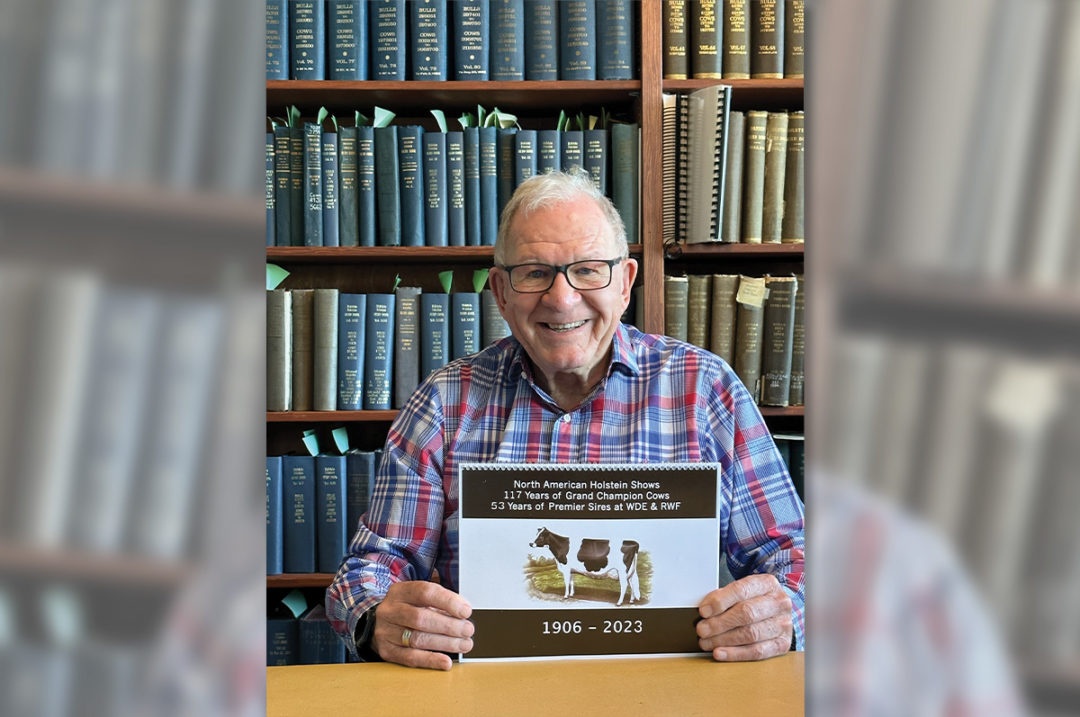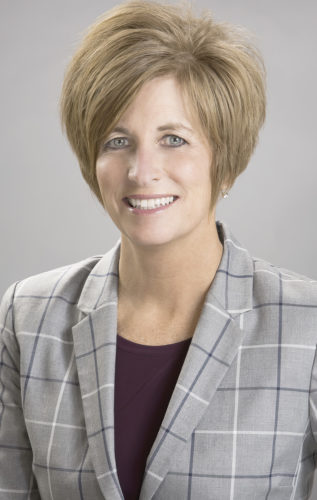Master geneticist Doug Blair has compiled an interesting list of past Grand Champions from the Royal Agricultural Winter Fair and the World Dairy Expo. His book covers not only the champions, but also their maternal line, including pedigree information back into the 1800s. Beyond the cow section is the information on the premier sires of the shows.
Blair is well known as the former founder and CEO of Alta Genetics. He served as the CEO of Alta for 36 years and, after retiring, continued as the chairman of the product development committee until 2014 for a total of 50 years in the A.I. industry.
In 2004, Blair partnered with Dr. David Chalack and Glenn Hockley in Rocky Mountain Holsteins. A highlight of that venture was winning the Senior Best Three Females class at the World Dairy Expo in 2011, with that group going on to be selected as the unanimous All-American group.
Blair has spent his time in retirement continuing a longtime practice of researching bloodlines and is compiling similar information of genomic bloodlines to a follow-up to his book North American Holstein Shows – 117 Years of Grand Champion Cows, 53 Years of Premier Sires at WDE & RWF.
What was the inspiration for this book?
BLAIR: I have always been interested in and participated in the show ring, starting with my 4-H calf when I was 10 years old. About 40 years ago, I started collecting the Herd Books of Holstein Canada and the set of four Herd Books in the U.S.
These books contained all the registrations back to 1871. I also obtained the Holstein World back to 1931 and the Canadian Holstein Journal starting in 1938. Being interested in cattle breeding and genetics, I started researching the pedigrees of the show winners at major shows. During COVID, I found the time to complete those studies.
How long did the research take?
BLAIR: I always did some research, primarily on Top 10 TPI sires starting in 1976 and LPI in 1992. Later, I did the Grand Champion cows. For each animal, I have recorded the direct maternal line back to the original heifer imported from the Netherlands to establish the cow family. I also included the sire stack.
One of the facts that I found most interesting was that there is no breeder on either side of the border that has dominated the Grand Champion award at national shows. What do you think that says about the prestige of the award and just how hard it is to attain an overall champion?
BLAIR: There probably are more than a million registered cows calving each year in the U.S. and Canada, so technically the odds are one in a million that a cow will win Grand Champion at the Royal Agricultural Winter Fair or the World Dairy Expo. Of course, only a small percentage reach the show ring at that level at all.
The reality is that no cow in either the U.S. or Canada has more than one daughter that has won a Grand Championship at the five major shows I researched. Only one Grand Champion cow has a daughter that also won Grand Champion. Another interesting fact is that only two breeders have bred three Grand Champions, and seven breeders have bred two Grand Champions. It is hard to win Grand Champion at these shows, and it is fitting that they get the prestige and recognition throughout the world.
Braedale Goldwyn dominated the Premier Sire awards. He won 20 times. What do you attribute that domination to?
BLAIR: He will probably be considered the type sire of this century. He certainly was not a type bull himself, as he scored GP-82 as a 3-year-old old and was raised GP-84 as an 8-year-old. His sire, Shoremar James, was GP-81 as a 2-year-old and that was it, but he sired Thrulane James Rose, a four-time Grand Champion winner.
When you study his pedigree, there are good reasons to support him being a top breeding bull. First, he is one of only a few bulls that were in the Top 10 LPI in Canada and also the Top 10 TPI in the U.S. The seven sires in his three-generation pedigree were all in the Top 10 LPI in Canada. Two bulls appear twice; Mark CJ Gilbrook Grand is his paternal grand-sire and also his maternal grand dam’s sire. Madawaska Aerostar, the first No. 1 LPI sire, is his sire’s dam’s grand-sire. Braedale Baler Twine, Goldwyn's dam, is a daughter of Madawaska Aerostar, adding to high type in his pedigree.
On the maternal side of Goldwyn’s pedigree, his maternal grand-dam, Braedale Gypsy Grand VG88, has proven to be an outstanding transmitter, especially when it comes to udders. She herself was a poster cow for Alta Genetics, always featuring her mammary system. She also has had a big impact on Canadian herds through successful A.I. sires. Gypsy had two sons in the Top 10 LPI; her daughter, Braedale Baler Twine, is the dam of Goldwyn as well as two other sons in the Top 10 LPI. Another daughter, Braedale Second Cut, was the dam of four Top 10 LPI Sires, including Gillette Windbrook, the sire of two Grand Champions.
In the direct maternal line of Goldwyn’s dam, we find Osborndale Ivanhoe, Whirlhill Kingpin and Lylehaven Lila Z, all descendants of Vrouka HHB9198+CAN448, who was born 1883.
Canadian-bred sires have won nearly all the Premier Sire awards at both events. What led to this trend and do you see it changing anytime soon?
BLAIR: Canadian A.I. units are fortunate to have had sires that appealed to breeders in both Canada and the U.S. Breeders are interested in sires that have excelled in the show ring. It started with the first multi-winner, Quality Ultimate, then Hilltopper Warden and Hanoverhill Starbuck, who were both Elevation sons, then came Goldwyn and now Croteaux Lesperron Unix.
Will it change? I think we will see more sires winning Premier Sire from both countries, as so many young bulls are being used these days.
What was the most interesting fact that you found in compiling all this information?
BLAIR: I thought there would be more show herds that would have bred a Grand Champion. For example, Hanover Hill won 12 times with five cows, but none bred by them. However, they excelled in breeding many top A.I. bulls in Canada. Hanover Hill did breed one cow that was Grand Champion at a major show, but she was owned by Pinehurst Farms of Wisconsin when she won.
I thought there would be more sires that would dominate the Grand Championship in their era, but only Goldwyn with eight, ABC with four and Starbuck with three have more than two daughters win, and most with only one.
Any other thoughts that you’d like to share?
BLAIR: I think it has been very interesting to study the pedigrees of the bulls that have had an impact on the breed. I expect this pattern will change as more cows are bred to young sires.
The shows have changed in nature, as in the early days breeders showed animals they bred to feature their herds. At the same time, they often were on the lookout for a winner in other herds.
Today, there are a smaller number of breeders who show bred and owned. Breeders with prospective show winners have found it to be a lucrative business to sell to the keen show-minded breeders. For example, in the 2022 All-American Holstein contest, of the 16 individual classes only one winner had a breeder that was part owner, and the rest were owned by others and often by multiple owners.










